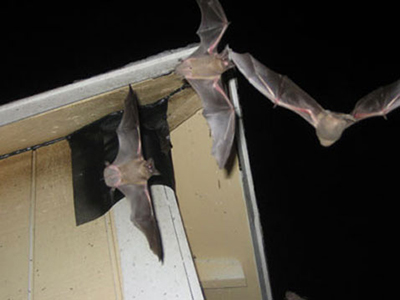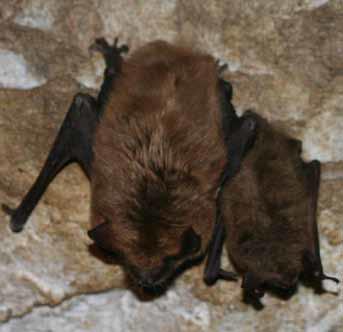Bat Control MN
Few wildlife species elicit such a range of reactions and emotions as bats. Bats are feared by some, while others are captivated by these unusual and often misunderstood creatures of the night.
Bats, the only mammals that truly fly, are a unique and interesting animal. Their ability to fly, their secretiveness, and their nocturnal habits have contributed to bat folklore, superstition, and fear.
In Minnesota and the surrounding states, bats are an important part of our ecology. One Little Brown bat can eat as many as 500-600 mosquitoes an hour for a total of two to five thousand a night. A colony of bats can eat 100’s of thousands of mosquitoes a night. Given the amount of mosquitoes we still have buzzing around us in the summer evenings, imagine the problem we would have if it weren’t for our winged friends of the night.
Out of the seven species of bats that we have in our area, three are tree dwellers and have little or no interaction with man. The other four species of bats found in Minnesota are cave dwellers, and unfortunately our homes appear to a bat as a large, convenient cave. The two species of bats that cause the majority of problems in Minnesota are the Large or Big Brown bat (Eptesicus fuscus), and the Little Brown bat (Myotis lucifugus).
Despite their ecological value, bats are relentlessly and unjustifiably persecuted. Bats are often killed because they live near people who needlessly fear them. These actions emphasize the need to educate the public on the reasons for bat conservation and why it is important to use safe, nondestructive methods to alleviate conflicts between people and bats.
Bat Exclusion
Minnesota has very few caves left for bats to hibernate in, so they have found something better. Your home!
 Bats commonly use your attic to rear their young. The most common bat/human interactions involve a single bat that has found its way into a house or a colony of bats that has taken up residence in an attic, chimney or other structure. Once inside, if the habitat is good, the colony grows until the homeowner notices the bats flying out of the building, notices the droppings in the attic, chimney, outside, or even basement. Sometimes a bat will get lost and find its way out of the attic and into the living area.
Bats commonly use your attic to rear their young. The most common bat/human interactions involve a single bat that has found its way into a house or a colony of bats that has taken up residence in an attic, chimney or other structure. Once inside, if the habitat is good, the colony grows until the homeowner notices the bats flying out of the building, notices the droppings in the attic, chimney, outside, or even basement. Sometimes a bat will get lost and find its way out of the attic and into the living area.
Bat control and Bat removal should be addressed as soon as they have been discovered. If you should discover bats in your house, the ONLY CONSISTENTLY SUCCESSFUL METHOD IS PERMANENT PHYSICAL EXCLUSION.
Exclusion is a time consuming process. Trapping a Bat humanely is important to prevent injury to the Bat. Getting rid of Bats is a process that should be carried out with proper planning and procedures.
It is very important that proper inspection techniques and exclusion methods be utilized. If not, you could end up with numerous adult and/or young bats being closed in your walls, eves, or attic, causing a large sanitation problem from bat droppings. Bats are still wild animals, subject to fleas, mites, lice and rabies, all of which don’t mix well in a family with kids and a couple dogs.
In Minnesota the best time to exclude bats is very early spring (as soon as it gets above 50 degrees at night) and September, which gives the bats enough time to find a new hibernation site.
As a protected species in many states, the capture and relocation of bats takes knowledge and experience. If your house is currently under attack by bats it is wise to call a Minnesota Wild Animal Management Expert that has experience in handling bat removals safely and in a timely manner.
Hiring a professional company guarantees the safety of you and your loved ones, along with prevention services to keep bats out for good.
Ask About Our Mice & Bat Exclusion Package, 4 Year Service Guarantee.





